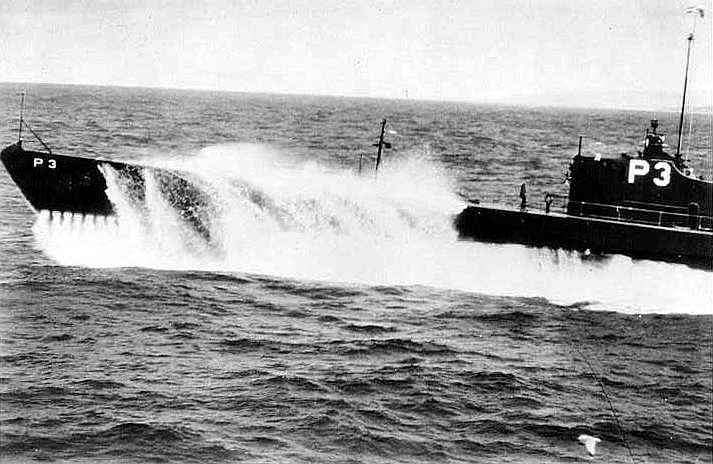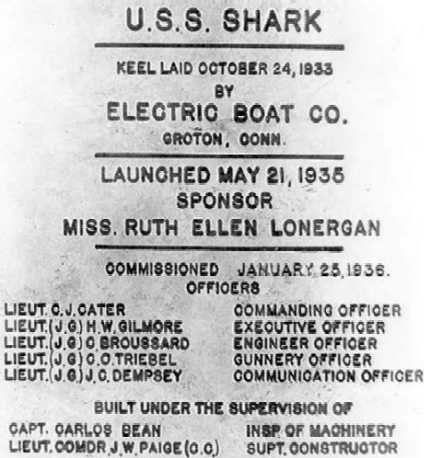
Following shakedown in the North Atlantic and the Caribbean, USS SHARK (SS-174) transited the Panama Canal and arrived at San Diego, Calif., on 4 March 1937. The submarine spent the next year and one-half in training exercises and Army-Navy war problems as a unit of SubRon6. Following a regular overhaul at Mare Island Navy Yard, Vallejo, Calif., SHARK got underway from San Diego on 16 December 1938 bound for Pearl Harbor and reassignment as a unit of SubRon4.
Following two years of operations in the Hawaii area, SHARK set sail from Pearl Harbor on 3 December 1940 to join the Asiatic Fleet based at Manila, Philippine Islands, where she engaged in fleet tactics and exercises until the Japanese attack on Pearl Harbor. Departing Manila on 9 December 1941, the submarine was at sea during the Japanese bombing raids on Manila the next day. For the next week, SHARK patrolled Tayabas Bay until ordered back to Manila on the 19th to embark Admiral Thomas C. Hart, Commander-in-Chief of the United States Asiatic Fleet (ComSubAF), for transportation to Soerabaja, Java.
After having transported Admiral Hart and other officials from Manila to Surabaya SHARK departed on 5 January 1942 for her second war patrol. She saw a torpedo, fired at her by an enemy submarine on 6 January, miss.
In anticipation of a possible enemy attack at Ambon (Amboina), ComSubAF directed SHARK to contact Dutch submarines at the harbor entrance of that island. On 25 January, SHARK was advised that heavy air raids on Ambon might indicate an enemy landing force moving toward the island.
Two days later SHARK was ordered to take station as part of a submarine group reconnoitering a major enemy move south through Molukka Passage. On 29 January, because another move toward Ambon was indicated, SHARK was ordered to cover the passage to the eat of Lifoematola. The next day this was enlarged to include the area to Bangka Passage. On 2 February SHARK reported to Surabaya that she had been depth charged 10 miles off Tifore Island and that she had missed on one torpedo attack.
Five days later SHARK reported an empty enemy cargo ship heading northeast. In answer to these messages, Surabaya pointed out that such transmissions contained little information of use in appraising the situation, and that they might very possible reveal to the enemy a position to avoid. No further messages were received from SHARK.
She was told on 8 February to proceed to Makassar Strait via the north coast of Celebes, and later was told to report information. Nothing further was heard from SHARK and on 7 March she was reported as presumed lost.
A Japanese report of antisubmarine attacks available now records at
least three which might have been on SHARK. One was east of Menado
on northern Celebes on 11 February 1942; the second was north of Kendari
on the southeast coast of Celebes on 17 February 1942; and the third was
east of Kendari on 21 February 1942. Also, in 1944, a Japanese press release
claimed that an enemy subchaser rammed a U.S. submarine in Manipa Strait
in February 1942. No mention is made of this attack in official Japanese
reports, but their reports are notoriously inaccurate and incomplete, especially
during the early part of the war. Since Dutch and English submarines were
operating in the area patrolled by SHARK, it is impossible to determine
whether any or all of the above mentioned attacks were survived by submarines
operating with our Asiatic Fleet. Loss of SHARK to an enemy minefield
is deemed improbable, since the enemy was on the offensive at this time
and would naturally hesitate to lay mines in the path of his advance down
the Strait of Makassar. Thus indications point to the probability that
SHARK was lost through enemy depth charge attack; however, the specific
attack responsible for the loss cannot be determined. The one on 11 February
off Menado is thought most likely, since SHARK had been ordered to northern
Celebes.
